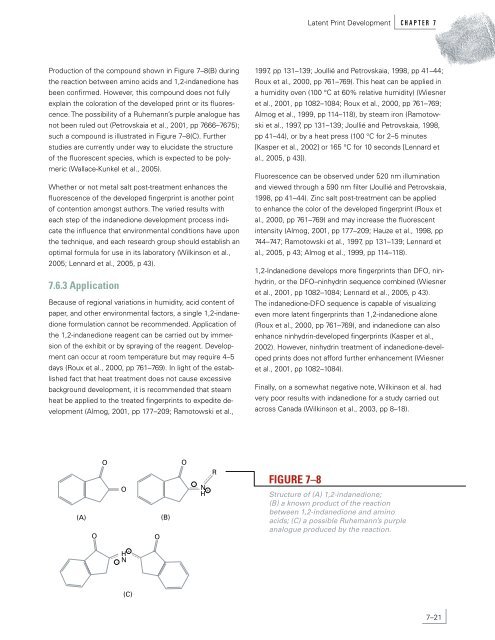Latent Print Development - National Criminal Justice Reference ...
Latent Print Development - National Criminal Justice Reference ...
Latent Print Development - National Criminal Justice Reference ...
Create successful ePaper yourself
Turn your PDF publications into a flip-book with our unique Google optimized e-Paper software.
Production of the compound shown in Figure 7–8(B) during<br />
the reaction between amino acids and 1,2-indanedione has<br />
been confirmed. However, this compound does not fully<br />
explain the coloration of the developed print or its fluorescence.<br />
The possibility of a Ruhemann’s purple analogue has<br />
not been ruled out (Petrovskaia et al., 2001, pp 7666–7675);<br />
such a compound is illustrated in Figure 7–8(C). Further<br />
studies are currently under way to elucidate the structure<br />
of the fluorescent species, which is expected to be polymeric<br />
(Wallace-Kunkel et al., 2005).<br />
Whether or not metal salt post-treatment enhances the<br />
fluorescence of the developed fingerprint is another point<br />
of contention amongst authors. The varied results with<br />
each step of the indanedione development process indicate<br />
the influence that environmental conditions have upon<br />
the technique, and each research group should establish an<br />
optimal formula for use in its laboratory (Wilkinson et al.,<br />
2005; Lennard et al., 2005, p 43).<br />
7.6.3 Application<br />
Because of regional variations in humidity, acid content of<br />
paper, and other environmental factors, a single 1,2-indanedione<br />
formulation cannot be recommended. Application of<br />
the 1,2-indanedione reagent can be carried out by immersion<br />
of the exhibit or by spraying of the reagent. <strong>Development</strong><br />
can occur at room temperature but may require 4–5<br />
days (Roux et al., 2000, pp 761–769). In light of the established<br />
fact that heat treatment does not cause excessive<br />
background development, it is recommended that steam<br />
heat be applied to the treated fingerprints to expedite development<br />
(Almog, 2001, pp 177–209; Ramotowski et al.,<br />
O<br />
O<br />
(A) (B)<br />
OO<br />
-<br />
H<br />
N<br />
+<br />
--- ---<br />
(C)<br />
O<br />
-<br />
---<br />
----<br />
N +<br />
H<br />
R<br />
1997, pp 131–139; Joullié and Petrovskaia, 1998, pp 41–44;<br />
Roux et al., 2000, pp 761–769). This heat can be applied in<br />
a humidity oven (100 °C at 60% relative humidity) (Wiesner<br />
et al., 2001, pp 1082–1084; Roux et al., 2000, pp 761–769;<br />
Almog et al., 1999, pp 114–118), by steam iron (Ramotowski<br />
et al., 1997, pp 131–139; Joullié and Petrovskaia, 1998,<br />
pp 41–44), or by a heat press (100 °C for 2–5 minutes<br />
[Kasper et al., 2002] or 165 °C for 10 seconds [Lennard et<br />
al., 2005, p 43]).<br />
Fluorescence can be observed under 520 nm illumination<br />
and viewed through a 590 nm filter (Joullié and Petrovskaia,<br />
1998, pp 41–44). Zinc salt post-treatment can be applied<br />
to enhance the color of the developed fingerprint (Roux et<br />
al., 2000, pp 761–769) and may increase the fluorescent<br />
intensity (Almog, 2001, pp 177–209; Hauze et al., 1998, pp<br />
744–747; Ramotowski et al., 1997, pp 131–139; Lennard et<br />
al., 2005, p 43; Almog et al., 1999, pp 114–118).<br />
1,2-Indanedione develops more fingerprints than DFO, ninhydrin,<br />
or the DFO–ninhydrin sequence combined (Wiesner<br />
et al., 2001, pp 1082–1084; Lennard et al., 2005, p 43).<br />
The indanedione-DFO sequence is capable of visualizing<br />
even more latent fingerprints than 1,2-indanedione alone<br />
(Roux et al., 2000, pp 761–769), and indanedione can also<br />
enhance ninhydrin-developed fingerprints (Kasper et al.,<br />
2002). However, ninhydrin treatment of indanedione-developed<br />
prints does not afford further enhancement (Wiesner<br />
et al., 2001, pp 1082–1084).<br />
Finally, on a somewhat negative note, Wilkinson et al. had<br />
very poor results with indanedione for a study carried out<br />
across Canada (Wilkinson et al., 2003, pp 8–18).<br />
FIGURE 7–8<br />
<strong>Latent</strong> <strong>Print</strong> <strong>Development</strong> C H A P T E R 7<br />
Structure of (A) 1,2-indanedione;<br />
(B) a known product of the reaction<br />
between 1,2-indanedione and amino<br />
acids; (C) a possible Ruhemann’s purple<br />
analogue produced by the reaction.<br />
7–21

















